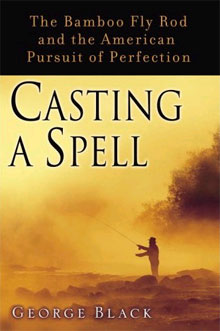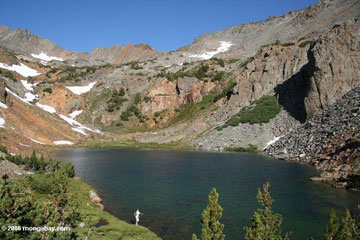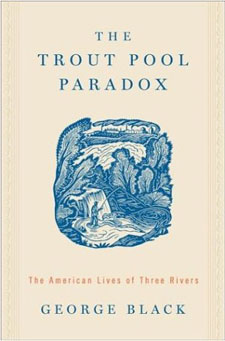Fly fishing, writing, and the environment:
An interview with George Black, author and articles editor of OnEarth Magazine
An estimated thirty-five million Americans fish. George Black is one of them. Black, based in New York City, has written two books on the subject: Casting a Spell: The Bamboo Fly Rod and the American Pursuit of Perfection and The Trout Pool Paradox: The American Lives of Three Rivers. He has also written for the New York Times, the Los Angeles Times, and a number of other publications as well as authoring three books on foreign affairs.
Today Black is articles editor of OnEarth, a publication put out by the Natural Resources Defense Council (NRDC), one of the largest environmental action organizations in the United States. Founded more than 35 years ago, NRDC employs legal tactics — especially lawsuits — and a $60 million budget to promote environmental protection through regulation. Along these lines, OnEarth focuses on the environment. In its own words, OnEarth “explores politics, nature, wildlife, culture, science, health, the challenges that confront our planet, and the solutions that promise to heal and protect it.” Contributors to the magazine include Rick Bass, Ian Frazier, William Greider, Edward Hoagland, Elizabeth Kolbert, Maxine Kumin, Bill McKibben, Richard Manning, Mary Oliver, Alex Shoumatoff, and other distinguished writers, poets, and photographers.
In January 2007, Black answered some questions about his passions — fly fishing, writing, and the environment.
NOTE: views expressed by Black in this interview are not necessarily those of NRDC or OnEarth Magazine
Mongabay: You are an avid fly fisherman and have written two acclaimed books on the subject. As a fisherman, what’s your take on the role of hunting and fishing in conservation efforts? Can we expect to see more alliances between conservation groups and outdoor enthusiasts in the future?

|
Black: There’s a lot of scope for cooperation, though the divisions seem to be hard to overcome—it’s very difficult for environmentalists to think intelligently about hunting, even where it’s a common-sense thing like culling deer populations that are out of control. And a lot of hunters tend to be pretty conservative and have a caricatured idea of environmentalists that’s shaped by a handful of the more radical groups who have been active on forests particularly (people who sit in trees or who drive spikes into them like Earth First!). Having said that, there are two issues that will increasingly unite the two groups. One is pressure on public lands from development, like the current oil and gas drilling boom in the Rocky Mountain West. The other, which is overwhelming, is global warming, which will threaten all kinds of wildlife habitat starting with trout streams. This will also bring in other outdoor recreation groups such as skiers, since snowpack is declining so rapidly.
Mongabay: As depicted in the film, “A River Runs Through It”, Montana seems to be a classic example of a fly fisherman’s paradise. However, the introduction of alien fish species including Rainbow Trout, Brook Trout, Brown Trout, and Northern Pike are threatening native species like the Cutthroat Trout. In general, have you heard much discussion among fisherman about this potential loss of biodiversity? Does better fishing make up for the loss of native species? Is biodiversity important to fishing?
 Fly fisherman in California. Photo by Rhett A. Butler |
Black: First thing is hats off to Montana for stopping stocking its rivers, which they did many years ago. I think the quality of fishing for entirely wild populations, plus the culture of catch-and-release, has convinced most people of the need to protect native stocks. And because fly fishermen know so much about bugs and the aquatic food chain, they have a head start in understanding why biodiversity matters so much.
Mongabay: What are the greatest threats to rivers in the United States? How about abroad?
Black: Abroad, it’s definitely the threat from mega-dams of the sort we stopped building here decades ago. China, India and other developing economies like Chile’s are all turning to hydropower as their magic bullet. In this country, the tide has turned against dams, but there are colossal threats from pollution (especially agriculture runoff, fertilizers, pesticides) and population pressures through suburbanization and sprawl.
Mongabay: Recently you wrote an article (“Patagonia Under Siege“) in OnEarth magazine, an NRDC publication, on threats to Doug Tompkins’ conservation project in Chile. What’s your take on the situation? Can private conservation initiatives work in the face of government opposition? What’s the strategy to convincing locals and the government that these areas are worth protecting even if it means forsaking big power contacts?
Black: Private conservation works in a lot of places, but it depends a lot on local history and familiarity with the idea. In Chile there’s almost zero experience with private philanthropy. In most developing countries, you won’t prevail through purely idealistic ecological arguments: it has to be a very hard-headed, pragmatic argument about dollars and cents – alternative energy strategies and economic growth models. The evidence is there, but it’s a long education struggle against deeply held preconceptions. In Chile, for example, the starting points are energy conservation (which almost no one is talking about) and the economic viability of the ecotourism alternative, which involves some very tough questions — first, it’s a seasonal industry at the moment, and there’s a real challenge making it year-round given climate, and second, no one has really worked up sophisticated enough economic models to show how viable it is.
Mongabay: When you write an article like “Patagonia Under Siege” do you see much of a local response? Is the article passed around at government meetings and such, or is it more targeted toward a U.S. audience who might be interested in contributing to conservation efforts?
Black: Not really. There’s very little cultural tradition of long-form narrative reporting in a lot of countries, even ones with a relatively sophisticated media environment like Chile’s. So this is much more for domestic consumption unfortunately. What Chilean debates will digest better is analytical positional papers on these issues.
Mongabay: Changing gears a bit, you used to cover international politics in your writing. How do you like the shift to writing about nature and the environment? How’s it different other than the subject matter?

|
Black: It’s refreshing for a lot of reasons. One, I just became jaded by working so much on wars and massacres and human rights violations. I once came home from dinner when my daughter was about eight, and said that a Mexican human rights activist I knew had just been murdered. My daughter looked at me and said, “Dad, why is that everyone you know always gets killed?” So that was a turning point. Writing about the environment takes me to more places, for one thing, but it’s also refreshing because there’s so much scope to talk about solutions rather than problems. On an issue like global warming, it’s great that we’re no longer voices in the wilderness. I think the situation is still dire and getting worse, but there’s been a real shift in public attitudes and a much greater willingness to find a way out of the crisis.
Mongabay: Do you pitch an article like “Patagonia Under Siege” to an editor or does an editor see the story and pass it to you as an accomplished writer.
Black: Question doesn’t really apply, since this is a story in the magazine that I edit — so I came up with the conception of the story, sold my colleagues on the idea, and went off and wrote it. Having said which, I still got the same kind of tough, critical edit from a colleague that I would expect from an editor at another publication.
Mongabay: Do you have any tips for aspiring nature/environment writers? Do you recommend focusing on writing-related majors in school? How about once you’re out of school? What about writing pitch letters?
Black: It’s a very crowded field — reminds me a little of how human rights was 10-15 years ago. I tend to have a very limited view of how much people can be “taught” to write. It’s not a paint-by-numbers business. I think immersion in experience is much more important. Pitch letters are really tough too — there are a million stories out there, and you’ve really got to persuade me that your idea is novel or takes a familiar subject from an imaginative new angle. Most pitches I see are very formulaic.
NOTE: views expressed by Black in this interview are not necessarily those of NRDC or OnEarth Magazine
George Black’s books include Casting a Spell: The Bamboo Fly Rod and the American Pursuit of Perfection and The Trout Pool Paradox: The American Lives of Three Rivers